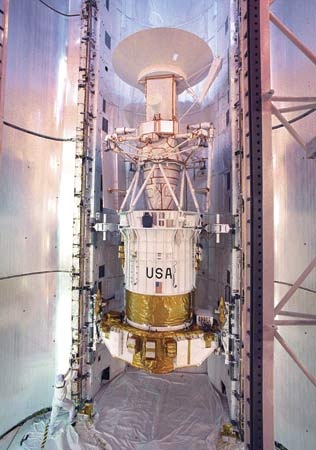Magellan
United States spacecraft
 U.S. spacecraft that from 1990 to 1994 used radar to create a high-resolution map of the surface of Venus.
U.S. spacecraft that from 1990 to 1994 used radar to create a high-resolution map of the surface of Venus. The Magellan spacecraft was launched by the National Aeronautics and Space Administration from the space shuttle on May 4, 1989. The primary spacecraft instrument was a synthetic aperture radar (radar) that could obtain images of the Venusian surface through the clouds that permanently surround the planet. Magellan arrived at Venus on Aug. 10, 1990, and was placed in an orbit over the planet's poles so that, as the planet rotated, the spacecraft could obtain images of almost all of its surface. There were three eight-month mapping cycles between 1990 and 1992; Magellan mapped 98 percent of the planet's surface with a resolution of 100 metres (330 feet) or better. The radar images showed that most of the surface was covered by volcanic materials, that there were few impact craters (suggesting that the surface is relatively young geologically), and that there was no evidence of plate tectonic (plate tectonics) activity or water erosion, although there was some evidence of wind erosion. The Magellan mission also determined the topography of the Venusian surface, measured the Venusian gravity field, and provided suggestive evidence that the planet's interior differs in major ways from Earth's interior. On Oct. 12, 1994, Magellan was sent to a crash landing on Venus.
The Magellan spacecraft was launched by the National Aeronautics and Space Administration from the space shuttle on May 4, 1989. The primary spacecraft instrument was a synthetic aperture radar (radar) that could obtain images of the Venusian surface through the clouds that permanently surround the planet. Magellan arrived at Venus on Aug. 10, 1990, and was placed in an orbit over the planet's poles so that, as the planet rotated, the spacecraft could obtain images of almost all of its surface. There were three eight-month mapping cycles between 1990 and 1992; Magellan mapped 98 percent of the planet's surface with a resolution of 100 metres (330 feet) or better. The radar images showed that most of the surface was covered by volcanic materials, that there were few impact craters (suggesting that the surface is relatively young geologically), and that there was no evidence of plate tectonic (plate tectonics) activity or water erosion, although there was some evidence of wind erosion. The Magellan mission also determined the topography of the Venusian surface, measured the Venusian gravity field, and provided suggestive evidence that the planet's interior differs in major ways from Earth's interior. On Oct. 12, 1994, Magellan was sent to a crash landing on Venus.- night lizard
- nightshade
- nigun
- nihilism
- Nihon keizai shimbun
- Nihon shoki
- Niigata
- Niihama
- Niihau
- Niitsu
- Nijhoff, Martinus
- Nijinsky, Vaslav
- Nijlen, Jan van
- Nijmegen
- Nijmegen, Treaties of
- Nijo Yoshimoto
- Nike
- Nike missile
- Nikisch, Arthur
- Nikita Ivanovich, Graf Panin
- Nikita Ivanovich Panin, Graf
- Nikita Sergeyevich Khrushchev
- Nikkatsu Motion Picture Company
- Nikki Giovanni
- Nikkō